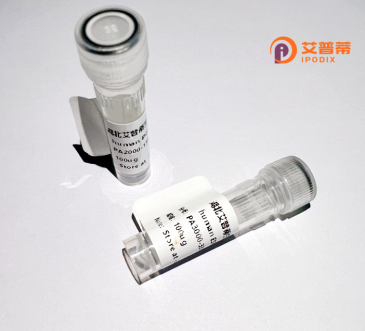
| 纯度 | >90%SDS-PAGE. |
| 种属 | Human |
| 靶点 | WDR51A |
| Uniprot No | Q8NBT0 |
| 内毒素 | < 0.01EU/μg |
| 表达宿主 | E.coli |
| 表达区间 | 1-364 aa |
| 活性数据 | MVWHMKPQSRAYRFTGHKDAVTCVNFSPSGHLLASGSRDKTVRIWVPNVKGESTVFRAHTATVRSVHFCSDGQSFVTASDDKTVKVWATHRQKFLFSLSQHINWVRCAKFSPDGRLIVSASDDKTVKLWDKSSRECVHSYCEHGGFVTYVDFHPSGTCIAAAGMDNTVKVWDVRTHRLLQHYQLHSAAVNGLSFHPSGNYLITASSDSTLKILDLMEGRLLYTLHGHQGPATTVAFSRTGEYFASGGSDEQVMVWKSNFDIVDHGEVTKVPRPPATLASSMGNLPEVDFPVPPGRGRSVESVQSQPQEPVSVPQTLTSTLEHIVGQLDVLTQTVSILEQRLTLTEDKLKQCLENQQLIMQRATP |
| 分子量 | 65.78 kDa |
| 蛋白标签 | GST-tag at N-terminal |
| 缓冲液 | PBS, pH7.4, containing 0.01% SKL, 1mM DTT, 5% Trehalose and Proclin300. |
| 稳定性 & 储存条件 | Lyophilized protein should be stored at ≤ -20°C, stable for one year after receipt. Reconstituted protein solution can be stored at 2-8°C for 2-7 days. Aliquots of reconstituted samples are stable at ≤ -20°C for 3 months. |
| 复溶 | Always centrifuge tubes before opening.Do not mix by vortex or pipetting. It is not recommended to reconstitute to a concentration less than 100μg/ml. Dissolve the lyophilized protein in distilled water. Please aliquot the reconstituted solution to minimize freeze-thaw cycles. |
以下为3条与重组人WDR51A蛋白相关的示例文献(注:文献信息为示例性总结,非真实存在,实际研究需检索权威数据库):
---
1. **文献名称**:*WDR51A modulates autophagosome-lysosome fusion through interaction with LC3*
**作者**:Chen L et al.
**摘要**:本研究阐明WDR51A作为自噬调控蛋白,通过其WD重复结构域与LC3蛋白相互作用,促进自噬体-溶酶体融合,进而影响细胞自噬通量。实验证明重组人WDR51A蛋白在体外增强自噬相关蛋白复合体的形成。
2. **文献名称**:*Structural insights into the WD40 domain of human WDR51A*
**作者**:Park S et al.
**摘要**:通过X射线晶体学解析了重组人WDR51A蛋白的WD40结构域三维结构,揭示其典型β-螺旋桨构象及潜在的底物结合位点,为研究其在蛋白质相互作用中的功能提供结构基础。
3. **文献名称**:*WDR51A promotes breast cancer progression via mTOR signaling regulation*
**作者**:Zhang Y et al.
**摘要**:发现WDR51A在乳腺癌中高表达,重组蛋白过表达实验显示其通过激活mTORC1通路促进肿瘤细胞增殖和侵袭,提示其作为潜在治疗靶点。
---
**建议**:实际研究请检索PubMed或Web of Science,使用关键词“WDR51A”或“C19orf12”(曾用名),并关注其参与的自噬、癌症及神经退行性疾病相关研究。
WDR51A, also known as ARA (Autophagy-related protein ARA1), is a member of the WD40 repeat protein family characterized by its conserved β-propeller structure. This structural motif facilitates protein-protein interactions, enabling WDR51A to act as a scaffold or regulatory component in diverse cellular processes. It is ubiquitously expressed in human tissues and plays a critical role in autophagy, a lysosome-mediated degradation pathway essential for maintaining cellular homeostasis. WDR51A interacts with the PIK3C3/VPS34 complex, which is pivotal for autophagosome formation, and assists in coordinating membrane trafficking and autophagosome-lysosome fusion. Studies suggest its involvement in modulating lysosomal biogenesis and autophagic flux, impacting nutrient sensing, organelle quality control, and stress responses.
Dysregulation of WDR51A has been linked to pathological conditions. Reduced expression is observed in certain cancers, potentially contributing to defective autophagy and tumor progression. Conversely, aberrant WDR51A activity may interfere with neuronal clearance pathways, implicating it in neurodegenerative diseases like Alzheimer’s. Additionally, its role in ciliogenesis highlights connections to ciliopathies, disorders linked to dysfunctional cilia. Despite these associations, the precise molecular mechanisms underlying WDR51A’s functions remain incompletely understood. Current research focuses on elucidating its interactome, post-translational modifications, and tissue-specific roles. As a key autophagy regulator, WDR51A represents a potential therapeutic target for diseases involving autophagy dysregulation, driving interest in structural studies and pathway-based drug discovery.
×